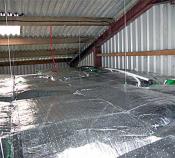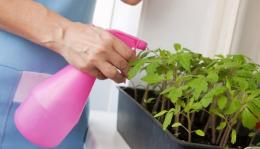Search
Login
Recommended
Late blight of tomatoes, late blight, causes late blight
Phytophthora is one of the most common diseases that affects tomatoes. That it can in just a few days deprive the owners of the plot of the entire crop. This common disease puzzles all gardeners, the main questions on this topic: how to spray tomatoes from late blight, late blight tomato treatment.
In order to understand the main reason for the manifestation of the disease, you need to understand: where exactly does it come from, what exactly provokes its occurrence.
Content
- Causes of late blight on tomatoes video
- Is phytophthora prevention possible video
- Phytophthora on potatoes video
- Phytophthora cucumbers
- Careful tomato care is an effective way to combat late blight
- Processing tomato from late blight
- Chemicals
- Processing Frequency
Causes of late blight on tomatoes
Tomatoes are closely related to vegetables such as potatoes and eggplant. They, in turn, are also susceptible to the harmful effects of late blight. From this we can draw a logical conclusion: to minimize the risk of contracting a disease that can be transmitted from plants of one species to another, it is not necessary to plant the described cultures at a close distance from each other.
Blight, quite often manifests itself in those places where, for some reason, a sufficient amount of air does not enter the plant. In this regard, experienced vegetable growers strongly recommend that all tomato bushes be planted. Moreover, it is necessary to do stepsoning in spite of the variety.

With special care, it is worth approaching the pinching of tomato varieties having not high or low stem growth. It is these varieties that are more susceptible to the manifestation of the disease, namely they, in the process of growth and the formation of a considerable amount of foliage, produce a kind of barrier that impedes the normal penetration of air.

An abnormal temperature regime for tomatoes can also cause late blight. Quite often, such situations can be repeated at the end of the summer period. It is when the night temperature can drop quite low. During this period, plants at risk of phytophthora should be given special attention.

Excessive moisture and low temperature are the most ideal conditions for the development of late blight on vegetable crops. With the advent of the rainy season, the tomato needs to create conditions as close as possible to greenhouse conditions. Only in this case, you can get a good harvest.
Tomatoes are plants that are very susceptible to excess moisture and moisture. Watering should not be frequent and very plentiful. Water must be poured exclusively under the root system. Water falling on the leaves will immediately cause the manifestation and further development of late blight disease.
Is phytophthora prevention possible
After finding out the main causes of the disease, you should choose a certain tactics of actions that will serve as a prevention of late blight.

In order to prevent the occurrence of late blight on tomatoes, timely and thorough prevention is necessary. First of all, it is necessary to minimize the harmful effects of all possible factors that are provocateurs of the disease.
Growing tomatoes in greenhouse conditions is an ideal option to protect the plant from late blight and to grow a decent crop.
In the greenhouse there is the possibility of:
- control the temperature and prevent sudden changes
- to place a greenhouse, you can choose the best place, near which there will be no vegetable plants that suffer from the same disease
- prepare the soil in the most thorough and proper way before planting seedlings
- pay proper attention to the soil surface, before installing the greenhouse, it is necessary to remove all the tops or any other remains of last year's plants on the surface, they may well contain infected fragments that will pass to young plants and deprive the owners of the crop.

The implementation of all the above actions is extremely important and of great importance. It is proved that phytophthora can persist on fragments of last year's plants in a state of suspended animation for quite a long time and, so to speak, wait for the right time to continue its existence on other living plants.
Phytophthora on potatoes
This vegetable plant is in first place at the risk of late blight. Based on this, the owner of the site should first of all carefully monitor the growth of potatoes. In addition to observation, timely and proper care of the plant should be carried out. This will help prevent the spread of an already appeared disease throughout the site.

A careful examination of potato tops will help to identify affected leaves and remove them in a timely manner. Mostly the affected foliage is located in the lower part of the stem. It is there that the environment is the wettest and most suitable for the development of pathogenic bacteria.

In addition, it will not be superfluous to conduct additional hilling. This process will help protect the tubers from infection. If the site is not too large in size and there is no way to leave a sufficiently large distance between vegetable crops suffering from the same diseases, you can make a kind of curtain, planted from, for example, green peas or beans.

These climbing plants will not allow the spread of the viral disease and will serve as a barrier between potatoes and tomatoes.
Phytophthora cucumbers
To date, late blight disease can be observed on such a vegetable crop as cucumbers. The peak of its distribution occurs around the month of July.

The development of late blight is affected by:
- A soil containing a large amount of lime. Most gardeners seek to reduce the acidity of the soil by adding lime to it. It is its excess that is an excellent environment for the development of a harmful fungus.
- Too many plants planted too close together. Quite often, such a misfortune happens with cucumbers in greenhouses, where for some reason they do not receive timely and sufficient ventilation. Constant increased humidity in greenhouse conditions is also detrimental.
- Sudden changes in the temperature of the environment. When the daytime temperature is significantly different from the nighttime, morning dew is inevitable. As a result, the increased spread of bacteria among the stems of cucumbers.
- Weakened plant immunity. This factor significantly reduces the plant's resistance to resistance to exposure and infection by bacteria of various kinds.
Phytophthora on cucumbers proceeds as follows. First of all, even with no armed gaze, you can detect a color change in the color of the stems and leaves. On a saturated green background, brown spots begin to appear. With significantly increased humidity, along with spots, a white coating appears.

Over time, and on the fruits, spots of the same color begin to emerge, while with a surface pressed inward. After a rather short period of time, the bacteria will spread throughout the fetus. This will lead to the beginning of the rotting process, the appearance of a foreign smell and, as a result, the loss of the entire crop.

In order to avoid cucumber diseases and get a rich harvest, it is necessary to eliminate all harmful factors as much as possible and provide timely and high-quality care to plants. It is always easier to prevent the spread of the disease than to deal with the consequences later.
Careful tomato care is an effective way to combat late blight
It is very important to pay sufficient attention to tomato growth. Since the plant loves dryness, and with the slightest excess of moisture, late blight begins to develop on them, it is worth periodically inspecting the leaves in the lower part. If the slightest hint of the formation or onset of a fungal disease is detected, the leaves should immediately be removed and eliminated (preferably outside the site). A high-quality and on-time inspection can avoid the harmful effects of fungi and keep the crop intact.

As already mentioned: the most protected tomatoes are those that grow in the greenhouse. All this is due to maintaining a favorable temperature regime, the possibility of keeping the humidity level under control by means of good ventilation, and also preventing possible infection from other often sick fungus vegetable crops, thanks to the film, which makes the design of the greenhouse almost airtight.
Processing tomato from late blight
In addition to the mandatory implementation of all measures for the prevention and elimination of factors that can provoke fungal infection in tomatoes, it is necessary to use organic and chemical agents on the plot to provide additional protection.
folk remedies for late blight
Amateur gardeners greatly praise the action of the composition, prepared with their own hands, in the fight against problems from late blight. To prepare the infusion, you need only onions and garlic. 200 g of their crushed mixture is diluted in a bucket of cool water and left to insist for 24 hours. After the agreed time, the infusion is ready to use. They can be sprayed with damaged plants (stems and leaves), as well as fruits, regardless of the degree of maturity.

To get the same good result, you can use kefir or yogurt. Phytophthora fungus is not able to cope with sour-milk fungus. Therefore, in such a struggle, dairy products win. It is not difficult to prepare an infusion. For every 100 grams of dairy product you need to add a couple of drops of iodine. The resulting mixture can be sprayed on affected plants.

Such a composition, along with anti-fungal action, will have a very positive effect on the quantity and quality of the tomato crop.
phytophthora copper wire
Such a component as copper is part of almost all solutions manufactured industrially and aimed at combating late blight. Copper solutions are also considered a good fertilizer for the proper growth of tomatoes and a high-quality and rich crop.

Quite often, copper wire is used for tying plants. To obtain a greater effect, experts advise to pierce the stem of the bushes with wire. The method, which involves laying a plate of copper under each of the tomato bushes, is widely known.
use tinder fungus infusion and chalk
With a fungal problem, a decoction of mushrooms will help to cope. The mushroom called tinder fungus has the greatest value in this matter. It is recommended to spray with such a decoction every one and a half to two weeks.

Prevention for tomatoes growing in a greenhouse can be carried out with a solution of chalk or with a composition of salt dissolved in water (1 cup of salt per 1 bucket of water). Salt will cover the leaves and fruits with a kind of film. It will serve as a barrier to fungal and other diseases.
How to spray tomatoes from late blight - chemicals
For owners of personal plots, skeptical of tips and folk recipes, specialized stores offer a fairly wide selection of drugs that eliminate the effects of fungal and other diseases affecting vegetable crops.

The most effective of all chemicals with a chemical composition are fungicides. They begin to be used a couple of weeks before transplanting seedlings into the greenhouse. The next similar treatment is carried out only 2 weeks after planting in the soil.

Then they process it after the flowering period has passed and the first ovaries appear. To obtain the maximum result from spraying of this kind, it is necessary to repeat it again, after some time.
Processing Frequency
Antifungal preventive actions are carried out only in dry and calm weather. The number of times of spraying with chemical compositions is directly proportional to the number of times of rainfall in a given region during a given summer period. In other words, the more it rains, the more often you need to spray.

In addition to spraying, it is very important to take time to regularly feed the plant. Fertilizing tomatoes with means specially designed for this will entail strengthening the immunity of the plant, which in turn will positively affect both the yield and resistance to the harmful effects of fungal and other diseases.
Proven fact: the stronger and more stable the tomato bush, the less various diseases will affect it. It must be remembered that the processing of chemical compounds is strictly prohibited during the period when the tomatoes begin to ripen.
If during this period there is a need for spraying from fungal diseases, then they are carried out only with the formulations proposed in the section of folk remedies for spraying.





